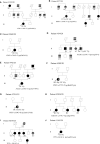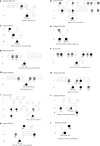Exome sequencing in BRCA1-2 candidate familias: the contribution of other cancer susceptibility genes
- PMID: 34026625
- PMCID: PMC8139251
- DOI: 10.3389/fonc.2021.649435
Exome sequencing in BRCA1-2 candidate familias: the contribution of other cancer susceptibility genes
Erratum in
-
Corrigendum: Exome Sequencing in BRCA1-2 Candidate Familias: The Contribution of Other Cancer Susceptibility Genes.Front Oncol. 2021 Aug 17;11:740860. doi: 10.3389/fonc.2021.740860. eCollection 2021. Front Oncol. 2021. PMID: 34485163 Free PMC article.
Abstract
Hereditary Breast and Ovarian Cancer (HBOC) syndrome is a condition in which the risk of breast and ovarian cancer is higher than in the general population. The prevalent pathogenesis is attributable to inactivating variants of the BRCA1-2 highly penetrant genes, however, other cancer susceptibility genes may also be involved. By Exome Sequencing (WES) we analyzed a series of 200 individuals selected for genetic testing in BRCA1-2 genes according to the updated National Comprehensive Cancer Network (NCCN) guidelines. Analysis by MLPA was performed to detect large BRCA1-2 deletions/duplications. Focusing on BRCA1-2 genes, data analysis identified 11 cases with pathogenic variants (4 in BRCA1 and 7 in BRCA1-2) and 12 with uncertain variants (7 in BRCA1 and 5 in BRCA2). Only one case was found with a large BRCA1 deletion. Whole exome analysis allowed to characterize pathogenic variants in 21 additional genes: 10 genes more traditionally associated to breast and ovarian cancer (ATM, BRIP1, CDH1, PALB2, PTEN, RAD51C, and TP53) (5% diagnostic yield) and 11 in candidate cancer susceptibility genes (DPYD, ERBB3, ERCC2, MUTYH, NQO2, NTHL1, PARK2, RAD54L, and RNASEL). In conclusion, this study allowed a personalized risk assessment and clinical surveillance in an increased number of HBOC families and to broaden the spectrum of causative variants also to candidate non-canonical genes.
Keywords: BRCA1; BRCA2; cancer susceptibility genes; HBOC, ES (Excome Sequencing).
Copyright 2021 Doddato, Valentino, Giliberti, Papa, Tita, Bruno, Resciniti, Fallerini, Benetti, Palmieri, Mencarelli, Fabbiani, Bruttini, Orrico, Baldassarri, Fava, Lopergolo, Lo Rizzo, Lamacchia, Mannucci, Pinto, Curr, Mancini, Oncologic Multidisciplinary Team, Azienda Ospedaliera Universitaria Senese, Oncologic Multidisciplinary Team, Azienda Usl Toscana Sud Est, Mari, Renieri and Ariani.
Conflict of interest statement
The authors declare that the research was conducted in the absence of any commercial or financial relationships that could be construed as a potential conflict of interest.
Figures


Similar articles
-
Germline variants in DNA repair genes associated with hereditary breast and ovarian cancer syndrome: analysis of a 21 gene panel in the Brazilian population.BMC Med Genomics. 2020 Feb 10;13(1):21. doi: 10.1186/s12920-019-0652-y. BMC Med Genomics. 2020. PMID: 32039725 Free PMC article.
-
Screening for BRCA1, BRCA2, CHEK2, PALB2, BRIP1, RAD50, and CDH1 mutations in high-risk Finnish BRCA1/2-founder mutation-negative breast and/or ovarian cancer individuals.Breast Cancer Res. 2011 Feb 28;13(1):R20. doi: 10.1186/bcr2832. Breast Cancer Res. 2011. PMID: 21356067 Free PMC article.
-
Hereditary breast and ovarian cancer: assessment of point mutations and copy number variations in Brazilian patients.BMC Med Genet. 2014 May 15;15:55. doi: 10.1186/1471-2350-15-55. BMC Med Genet. 2014. PMID: 24884479 Free PMC article.
-
[Current clinical issues and recent trends in hereditary breast and ovarian cancer in Japan-genetic testing for HBOC and risk-reducing surgery].Gan To Kagaku Ryoho. 2014 Nov;41(11):1333-9. Gan To Kagaku Ryoho. 2014. PMID: 25434434 Review. Japanese.
-
Recommendations for Preventive Care for Women with Rare Genetic Cause of Breast and Ovarian Cancer.Klin Onkol. 2019 Summer;32(Supplementum2):6-13. doi: 10.14735/amko2019S6. Klin Onkol. 2019. PMID: 31409076 Review. English.
Cited by
-
Multi-gene panel testing increases germline predisposing mutations' detection in a cohort of breast/ovarian cancer patients from Southern Italy.Front Med (Lausanne). 2022 Aug 11;9:894358. doi: 10.3389/fmed.2022.894358. eCollection 2022. Front Med (Lausanne). 2022. PMID: 36035419 Free PMC article.
-
Polymorphisms and Pharmacogenomics of NQO2: The Past and the Future.Genes (Basel). 2024 Jan 10;15(1):87. doi: 10.3390/genes15010087. Genes (Basel). 2024. PMID: 38254976 Free PMC article. Review.
-
Effect of Rho GTPase activating protein 9 combined with preoperative ratio of platelet distribution width to platelet count on prognosis of patients with serous ovarian cancer.Transl Cancer Res. 2021 Oct;10(10):4440-4453. doi: 10.21037/tcr-21-1946. Transl Cancer Res. 2021. PMID: 35116301 Free PMC article.
-
Genetic analyses of DNA repair pathway associated genes implicate new candidate cancer predisposing genes in ancestrally defined ovarian cancer cases.Front Oncol. 2023 Mar 8;13:1111191. doi: 10.3389/fonc.2023.1111191. eCollection 2023. Front Oncol. 2023. PMID: 36969007 Free PMC article.
-
The Identification by Exome Sequencing of Candidate Genes in BRCA-Negative Tunisian Patients at a High Risk of Hereditary Breast/Ovarian Cancer.Genes (Basel). 2022 Jul 22;13(8):1296. doi: 10.3390/genes13081296. Genes (Basel). 2022. PMID: 35893033 Free PMC article.
References
-
- Ford D, Easton DF, Bishop DT, Narod SA, Goldgar DE. Risks of Cancer in BRCA1-mutation Carriers. Breast Cancer Linkage Consortium. Lancet (London England) (1994) 343:692–5. - PubMed
LinkOut - more resources
Full Text Sources
Research Materials
Miscellaneous

